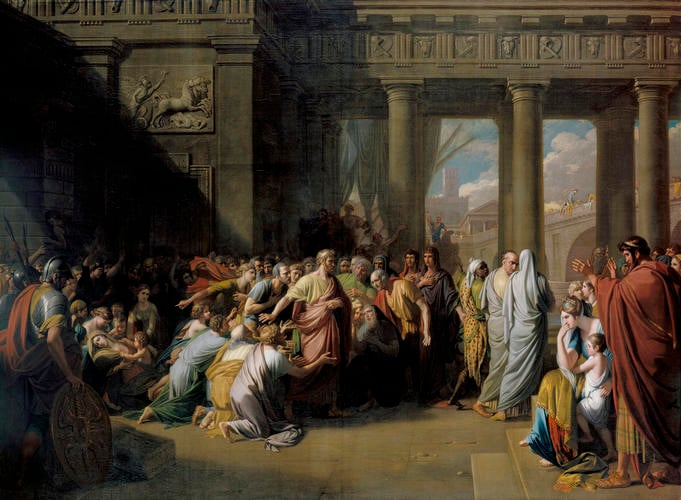-
1 of 253523 objects
The Departure of Regulus Signed and dated 1769
Oil on canvas | 225.4 x 307.2 cm (support, canvas/panel/stretcher external) | RCIN 405416
-
This is one of three pairs of neo-classical history paintings, painted between 1769 and 1773, commissioned by George III to hang in his ‘Warm Room’ (a private sitting room) at Buckingham Palace (OM 1152-7, 405416-7, 405683-4 and 407524-5), along with one modern scene, the Death of Wolfe (OM 1167, 407297). This one pairs off with the Oath of Hannibal (OM 1153, 405417) of 1770. The first commission was placed in February 1768 when West showed the King his picture of Agrippina with the ashes of Germanicus which he had just completed for Robert Hay Drummond, Archbishop of York. The King commented upon the rarity of the subject and proposed ‘another noble Roman subject . . . I mean the final departure of Regulus from Rome’; he then commenced to read Livy’s account of the story to the artist. Regulus, the Roman consul and general, was taken prisoner by the Carthaginians in 255 BC. He was sent back to Rome to discuss peace terms and an exchange of prisoners. However, Regulus distrusted the peace negotiations and insisted on returning to certain torture and death in Carthage. West’s painting is set within a neo-classical composition that reflects - amongst other things - the Raphael Cartoons in the King’s collection, which West greatly admired. From 1763 to 1787 the Cartoons hung in the Saloon at Buckingham House where West - and other artists - could have seen them.
West’s arrival in England from Italy in 1763 occurred at a time when artists were seeking to create a distinguished national school of history painting. George III was eager to support such a goal and Benjamin West was able to fulfil such aspirations remarkably well. The King was also a keen supporter of the proposal to found a national academy for the teaching and display of arts. His patronage of West and the foundation of the Royal Academy in 1768 were closely intertwined. At the King’s instruction, The Departure of Regulus was shown at the first Royal Academy exhibition in 1769, and of the 136 works included, it most completely represented the high-minded art that the Academy had been founded to encourage. However, only West was really able to produce a great body of history painting as only he enjoyed sustained royal patronage, while other distinguished artists continued to fulfil the demand for portraiture. He succeeded Sir Joshua Reynolds as President of the Royal Academy in 1792.
West painted around sixty pictures for George III between 1768 and 1801. From 1772 he was described in Royal Academy catalogues as ‘Historical Painter to the King’ and from 1780 he received an annual stipend from the King of £100. In the 1780s he gave drawing lessons to the Princesses and in 1791 he succeeded Richard Dalton as Surveyor of the King’s Pictures. During these years West effectively monopolised all royal patronage except for portraiture, although he did paint many royal portraits as well. His main subject-matter was history painting - a category which included classical and medieval as well as recent historical events, such as his famous image of the death of General Wolfe at Quebec in 1759.
Originally signed and dated Benj. West / pinxit / Londini 1769
Catalogue entry adapted from George III & Queen Charlotte: Patronage, Collecting and Court Taste, London, 2004Provenance
Painted for George III; recorded in the King's Warm Room at Buckingham Palace in 1774 (see RCIN 926308), 1790 and 1819 (no 766); in the Queen's Drawing Room at Hampton Court in 1835 (no 419) and 1861 (no 501)
-
Creator(s)
Acquirer(s)
-
Medium and techniques
Oil on canvas
Measurements
225.4 x 307.2 cm (support, canvas/panel/stretcher external)
256.4 x 338.5 x 13.0 cm (frame, external)
Category
Object type(s)
